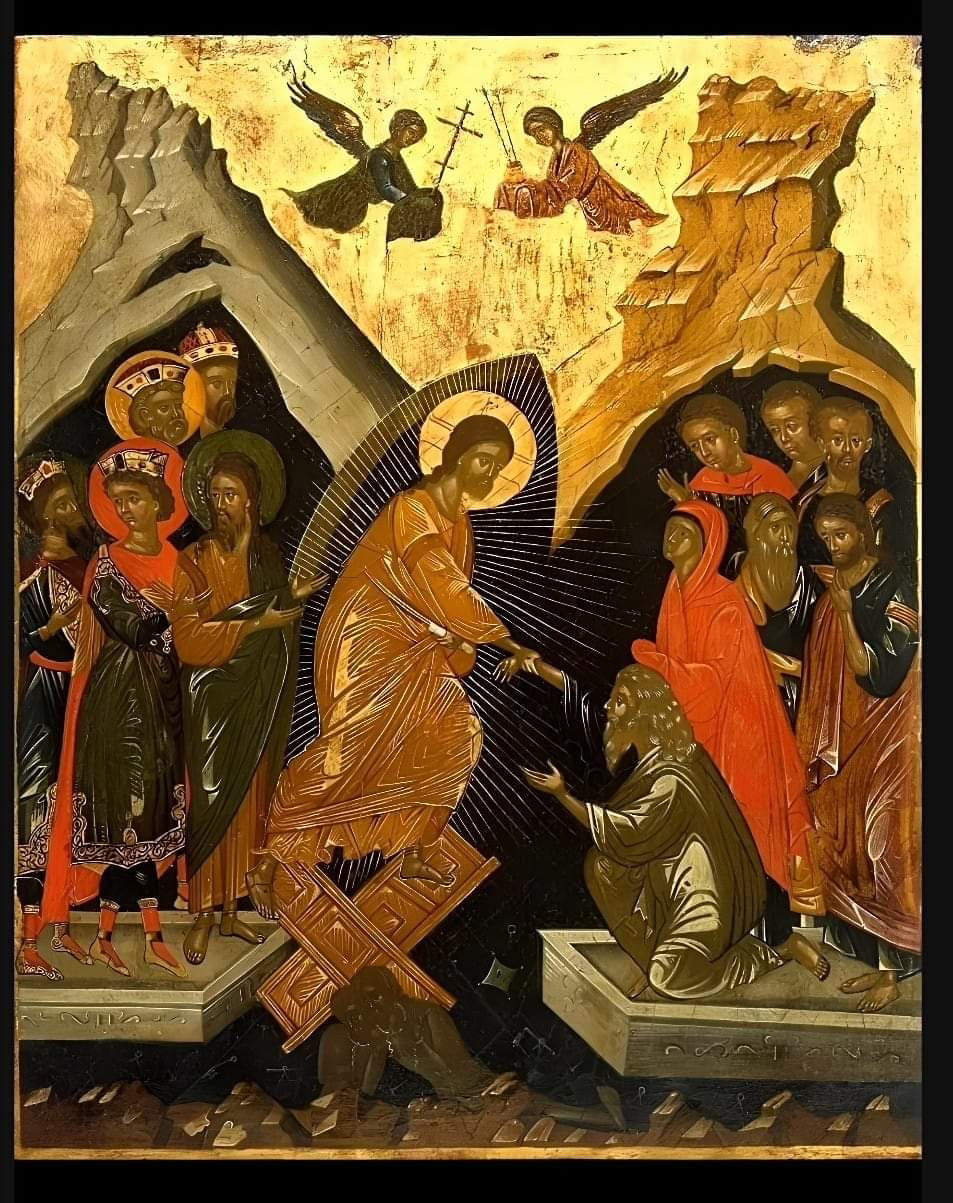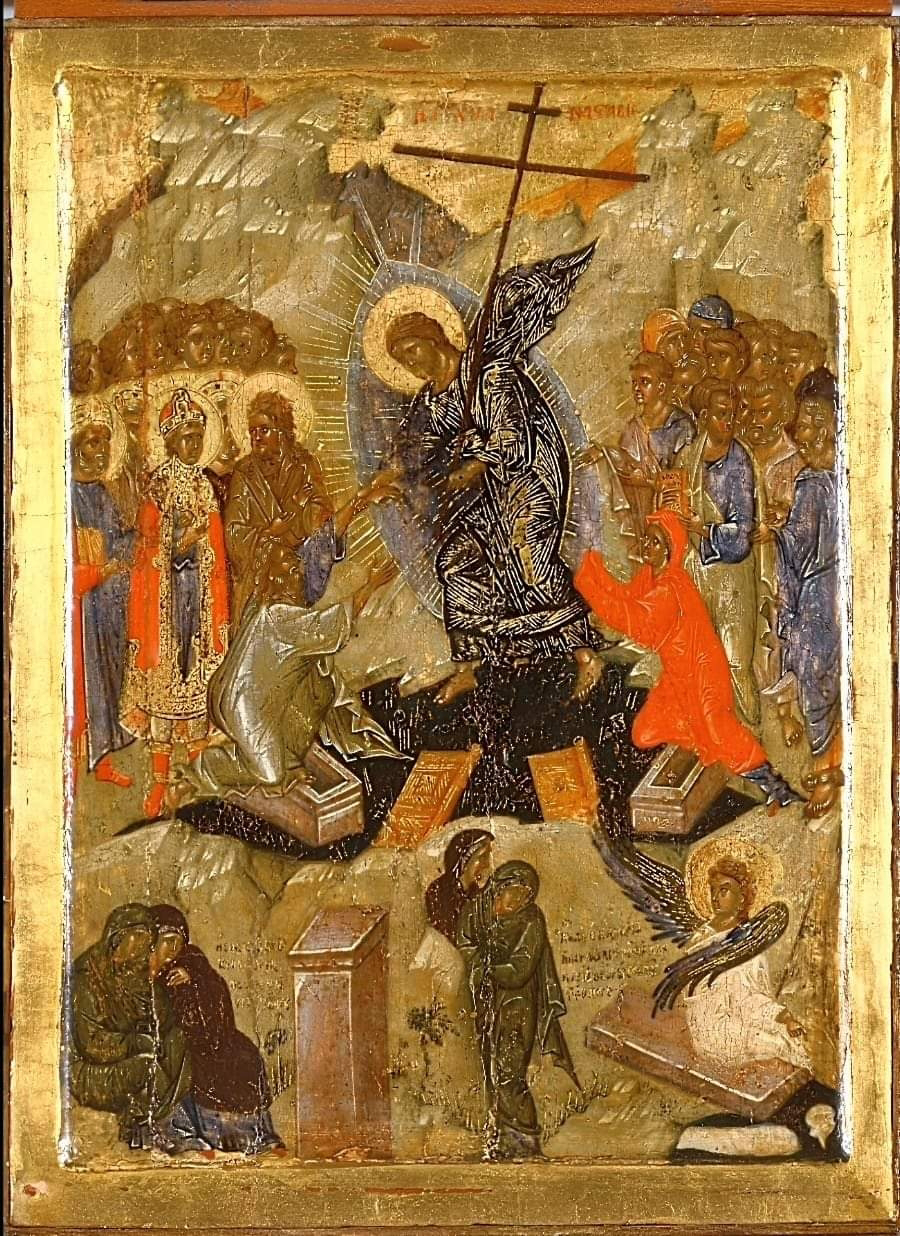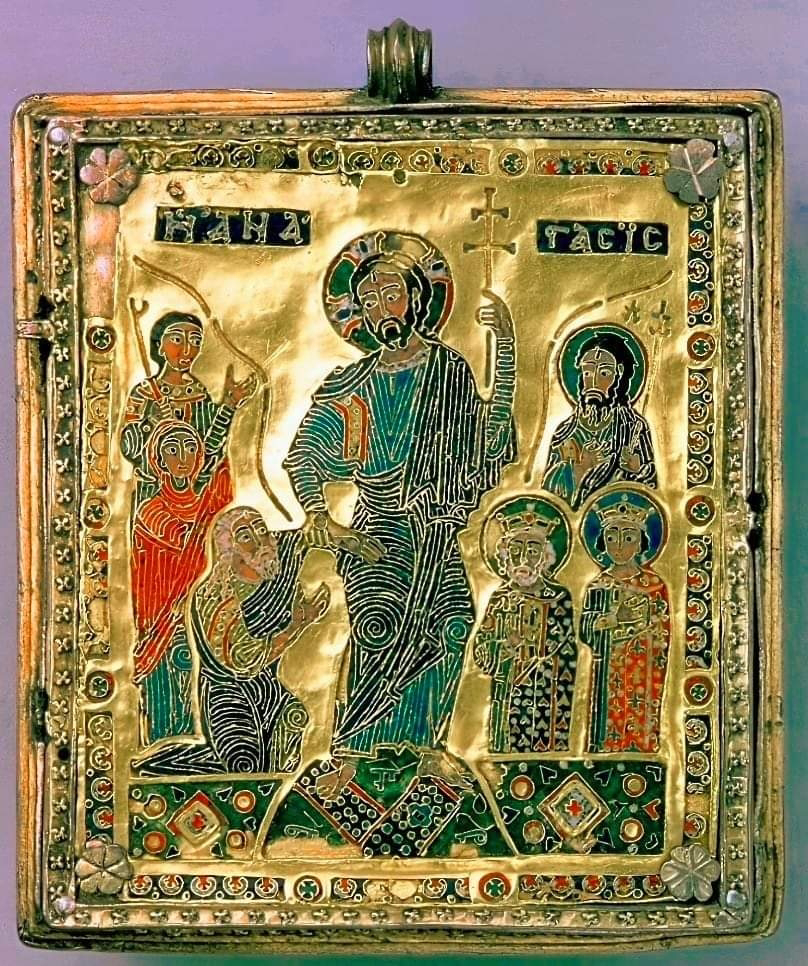Το θέμα αὐτῆς τῆς εἰκόνας ἐμφανίστηκε στο Βυζάντιο πι θανώς τον 12ο αιώνα και βασίστηκε κατά πολύ στη μαρτυρία που περιέχει το απόκρυφο Εὐαγγέλιο τοῦ Νικοδήμου. Ο Κύριος ἀναπαριστάνεται σε κίνηση Καθόδου πρός τόν
Ἅδη" περιτριγυρίζεται ἀπό λάμψεις που διασχίζουν ἀκτῖνες, από οὐράνιους κύκλους πού ἐπισημαίνουν τήν ὑπεροχή καί τή θεϊκή του δόξα. Γύρω από τον Σωτήρα μαζεμένοι οἱ ἅγιοι Προπάτορες, οἱ μάρτυρες τῆς Παλαιᾶς Διαθήκης, οἱ ὁμολογη τές καί οἱ προφήτες. Ανάμεσα στούς προφήτες ὁ Ἰωάννης ὁ Βαπτιστής ὁ ὁποῖος στάλθηκε με τον θάνατό του ἀπό τόν Ἡ- ρώδη στον "Άδη ν' ἀναγγείλει τή μέλλουσα Ανάσταση τοῦ Χριστοῦ καί τήν κάθοδό του στον Ἄδη. Ὁ Σωτήρας πατᾶ τίς σπασμένες πύλες τοῦ Ἅδη. Κρατᾶ τὸν Σταυρό, λάβαρο τῆς νίκης του ἐναντίον τοῦ θανάτου. Απλώνει το χέρι του στούς πρωτοπλάστους Αδάμ καί Εὔα ἐγείροντάς τους δυναμικά από τὸ μνῆμα. Το μνῆμα δείχνει τήν κατάρα τοῦ θανάτου πού ὑπέστησαν οἱ παρακούοντες τή θεϊκή εντολή. Σ' αὐτό τό σημεῖο ή εἰκόνα ὑπογραμμίζει ἰδιαίτερα τήν ἔννοια τῆς ἀνάστασης, την ἀνέγερση ἀπό τήν πρώτη πτώση, τη συντριβή τοῦ τάφου -σήμα θανάτου. Ο Σωτήρας παρουσιάζεται σ' αὐτήν τήν εἰκόνα σαν ἥλιος πού κατεβαίνει στον "Άδη. Κάθε του κίνηση εἶναι γεμάτη από ὀρμή. Οἱ ἄκρες τοῦ ἐνδύματός του εἶναι γυρισμέ νες καί σηκωμένες ἀπό τήν ὀρμητική δύναμη τῆς κατάβασής του στον Άδη. Τά πόδια του πατοῦν τις σπασμένες πύλες τοῦ κάτω κόσμου, ριγμένες σε σχῆμα σταυροῦ πάνω στο χάος - βασίλειο τῆς Κόλασης καί τοῦ Θανάτου, σαν ἕνα ἄλλου εἴδους τόξο στο χέρι ἑνός πολεμιστῆ. Ὁ Κύριος μέ τό δεξί του χέρι κρατά γερά τό χέρι τοῦ ᾿Αδάμ καί κουρασμένο από τον θανάτιο ὕπνο του τον τραβᾶ ἔξω ἀπό τόν τάφο. Το αριστερόχέρι τοῦ ᾿Αδάμ, ἀδύναμο, μοιάζει να ξεκουράζεται μέσα στο χέρι τοῦ Χριστοῦ. Ἡ κίνηση τοῦ δεξιού χεριοῦ τοῦ Ἀδάμ, κί- νηση αὐτόνομη, έκφράζει την προσωπική θέλησή του καί τεί νει πρός τόν Χριστό σαν προσευχή. Μ' αὐτήν τήν ἀντιθετική κίνηση τῶν χεριῶν τοῦ ᾿Αδάμ ἀνοίγεται μυστικά ή ἀναζωογόνηση τοῦ ἀνθρώπου που πηγάζει από τήν ἀνάσταση, ἡ πλήρης κατάργηση τοῦ θανάτου, ἡ ἐσωτερική δύναμη τῆς ψυχῆς ποὺ τείνει πρός τόν Θεό. Στό πρόσωπο τοῦ ἀναστημένου Αδάμ σαλεύουν μὲ τὸν ἴδιο τρόπο ή φθορά τοῦ θανάτου καί ή χαρά τῆς νέας συνάντησής του μέ τόν Δημιουργό του. Στήν ἀπέναντι ὄχθη τοῦ Ἅδη ή Εύα γονατισμένη, μέ καλυμμένα τα χέρια της ἀπό τίς άκρες τοῦ ἐνδύματός της τ' απλώνει πρός τόν Κύριο. Στα δεξιά τοῦ Χριστοῦ, ὁ χορός τῶν Προφητῶν μ' ἐπικεφαλῆς τον Πρόδρομο, πού εἶχε ἀναγγείλει στον κάτω κόσμο, μετά το μαρτύριό του, την Ανάσταση τοῦ Κυρίου. Στό άριστερό χέρι τοῦ Λυτρωτῆ, ἀπό τήν πλευρά τῆς Εὔας, βλέπουμε τόν χορό τῶν Προπατόρων. Τα βουνά στο ἄνω μέρος τῆς εἰκόνας, πλησιάζοντας τις κορυφές τους, σημειώνουν κι αὐτά το «πέρασμα» τῆς κατάβασης στόν Ἅδη. Ακριβῶς πάνω από τα βουνα δυό ἄγγελοι με τα σύμβολα τοῦ Πάθους: τον Σταυρό, τόν κάλαμο με τον σπόγγο τοῦ ὅξους καί τῆς χολῆς καί τό μαστίγιο.
Εἶναι ὁ θρίαμβος τῆς ἀπελευθέρωσης ἀπό τόν βαρύ ὕπνο τοῦ Θανάτου. Νά γιατί ὁ Χριστός τῆς ᾿Ανάστασης εἰκονίζεται μέ αὐτόν τον δυναμικό τρόπο, τῆς διάρρηξης τῶν δεσμῶν τοῦ Ἅδη, τῆς ἔγερσης ἀπό τόν τάφο, τῆς νίκης πάνω στη δύναμη τῆς γῆς ποὺ εἶναι εἰκόνα τῆς ἁμαρτωλότητάς μας, τῆς φθαρτότητάς μας, εἰκόνα τῆς ὑποταγῆς μας στον θάνατο. Στήν εἰκόνα τῆς Ἀνάστασης ὁ Χριστός Σωτήρας γίνεται καθοδηγητής τοῦ ἀνθρώπινου γένους, πού καλεῖ ὅλο τον κόσμο να τόν ἀκολουθήσει γίνεται ὁ ἀγγελιαφόρος τῆς γενικῆς ἀνάστασης.
Το θέμα τῆς «εἰς Ἅδου Καθόδου» ἐμφανίστηκε για πρώτη φορά στο Βυζάντιο καί διαδόθηκε αργότερα στη Δύση. Μέσα στη ρωμαιοκαθολική Εκκλησία, ὅμως, ἡ εἰκόνα ἔχασε το νόη μά της, έχασε τόν εἰδικό, πνευματικό χαρακτήρα της άρχισε ή Ανάσταση να παρουσιάζεται σάν ἕνα στιγμιαίο γεγονός, μυστηριώδες καί ἀπρόσιτο, φορτωμένο μ' ένα πλήθος λεπτομερειῶν, ὅπως οἱ πεσμένοι στρατιώτες μπροστά στον τάφο, βλέποντας τήν ἔγερση τοῦ Χριστοῦ. Στη συνέχεια ἡ εἰκόνα αὐτή γινόταν ὅλο καί πιό πιστή στό στιγμιαῖο γεγονός τῆς ἱστορικῆς ἀφήγησης, προσπαθώντας να δείξει ἕνα πανόραμα αίσθη- τῶν πραγμάτων: ὅσων «τό μάτι δέν εἶδε καί τό αὐτί δέν ἄκουσε». Κατέληξε μιά παραμορφωμένη μαρτυρία τῆς Ἀνάστασης τοῦ Χριστοῦ, κατά τόν πατριάρχη Σέργιο. Ο Λεωνίδας Οὐσπένσκυ ἀναφέρει τήν ἐξήγηση τοῦ ᾿Αβελάρδου, λέγοντας πώς ἡ ἀναπαράσταση τῶν στρατιωτῶν εἶναι ἀπαραίτητη σάν μαρτυρία πού πιστοποιεῖ τήν αὐθεντικότητα κάθε γεγονότος ἀλλά οἱ στρατιῶτες ὑπῆρξαν μάρτυρες, ὄχι θεατές τῆς ἴδιας τῆς στιγμῆς τῆς ᾿Ανάστασης.
Μ' αὐτή τή μορφή, τήν ἀπομακρυσμένη καί ἀλλοιωμένη, ή εἰκόνα τῆς ᾿Ανάστασης, ἔτσι ὅπως διαμορφώθηκε ἀπό τή ρωμαιοκαθολική Εκκλησία, ἐπιστρέφει στήν ὀρθοδοξία, μή ἔχοντας διατηρήσει μέσα της τίποτε ἄλλο παρά τήν ἰδέα τῆς Ἀνάστασης, «διδάσκοντας» κατά κάποιο τρόπο τό μυστήριο τοῦ Θεοῦ. Κι εἶναι ή περίπτωση πολλῶν εἰκόνων. Μέσα σ' ἕνα περιβάλλον ξεκομμένο ἀπό τήν ἐνότητα τῆς Ἐκκλησίας οἱ εἰκόνες ἀρχίζουν να νεκρώνονται, νά παραμορφώνονται, να χάνουν τή ζωτική δύναμή τους γιά νά ξαναβροῦν τό πρώτο τους φῶς καί νά λάμψουν, πρέπει νά ἐπιστρέψουν στήν ἐκκλησιαστική πηγή πού τίς γέννησε. Νά ὑποφέρουν, να πεθάνουν μέ τόν Χριστό καί νά ἀναστηθοῦν μαζί Του.
Πηγή:
ΣΗΜΕΙΩΣΕΙΣ ΕΝΟΣ ΕΙΚΟΝΟΓΡΑΦΟΥ .
Π.Γρηγορίου Κρούγκ. Εκδοσεις Παναγόπουλου
Μεταφραση Σπυριδωνος Μαρίνη
THE DESCENT INTO THE HADES
The subject of this icon appeared in Byzantium in the 12th century and was based largely on the testimony contained in the apocryphal Gospel of Nicodemus. The Lord is represented in a movement of descent towards the
Hades', surrounded by flashes of lightning crossing rays, by heavenly circles which indicate his supremacy and divine glory. Around the Saviour are gathered the holy forefathers, the martyrs of the Old Testament, the confessors and the prophets. Among the prophets was John the Baptist, who was sent by Herod to Hades at his death to announce the future resurrection of Christ and his descent into Hades. The Saviour stepped through the broken gates of Hades. He held the Cross, the banner of his victory over death. He extends his hand to the firstborn Adam and Eve, raising them powerfully from the monument. The memorial shows the curse of death suffered by those who disobeyed the divine command. At this point the icon particularly emphasizes the meaning of the resurrection, the rising from the first fall, the shattering of the tomb - the sign of death. The Saviour is presented in this icon as the sun descending into "Hades. His every movement is full of momentum. The edges of his garment are turned and lifted by the impulsive force of his descent into Hades. His feet tread the broken gates of the underworld, cast in the shape of a cross on the chaos - the realm of Hell and Death, like a different kind of bow in the hand of a warrior. The Lord with his right hand firmly holds Adam's hand and, tired from his deathly sleep, pulls him out of the tomb. Adam's left hand, weak, seems to rest in the hand of Christ. The movement of Adam's right hand, an autonomous movement, expresses his personal will and tends towards Christ as a prayer. With this contrasting movement of Adam's hands, the revival of man that comes from the resurrection, the complete abolition of death, the inner power of the soul that tends towards God, is secretly opened up. In the face of the resurrected Adam, the decay of death and the joy of his new encounter with his Creator are in the same way dissolved. On the opposite bank of Hades, Eve kneels down, her hands covered by the edges of her garment, and stretches them out towards the Lord. On the right of Christ, the choir of the Prophets, headed by the Baptist, who announced to the world below, after his martyrdom, the resurrection of the Lord. On the left hand of the Redeemer, on the side of Esau, we see the choir of the Prophets. The mountains in the upper part of the picture, approaching their peaks, also mark the "passage" of the descent into Hades. Directly above the mountains, two angels with the symbols of the Passion: the Cross, the reed with the beech and chalice spigot and the whip.
It is the triumph of deliverance from the heavy sleep of Death. That is why the Christ of the Resurrection is depicted in this dynamic way, of breaking the bonds of Hades, of rising from the grave, of victory over the power of the earth, which is the image of our sinfulness, our perishability, the image of our submission to death. In the image of the Resurrection, Christ the Saviour becomes the guide of the human race, calling all the world to follow him, becoming the messenger of the general resurrection.
The theme of the "Ascension" appeared for the first time in Byzantium and later spread to the West. Within the Roman Catholic Church, however, the image lost its meaning, lost its special, spiritual character, and the Resurrection began to be presented as an instantaneous event, mysterious and inaccessible, loaded with a multitude of details, like the fallen soldiers in front of the tomb, seeing the resurrection of Christ. Then this image became more and more faithful to the momentary event of the historical narrative, trying to show a panorama of sensual things: what "the eye did not see and the ear did not hear". He ended up with a distorted testimony of the Resurrection of Christ, according to Patriarch Sergius. Leonidas Uspensky quotes the explanation of ᾿Abelardus, saying that the representation of the soldiers is necessary as a testimony attesting to the authenticity of each event, but the soldiers were witnesses, not spectators of the very moment of the Resurrection.
In this form, distant and altered, the image of the Resurrection, as it was formed by the Roman Catholic Church, returns to Orthodoxy, having retained in it nothing else but the idea of the Resurrection, "teaching" in a way the mystery of God. And it is the case of many icons. In an environment cut off from the unity of the Church, icons begin to die, to become deformed, to lose their vitality, to regain their first light and shine, they must return to the ecclesiastical source that gave birth to them. To suffer, to die with Christ and to rise with Him.
Source:
NOTES OF AN IKONOGRAPHER.
Fr. Gregory Krug. Panagopoulos Publications.
Translation by Spyridon Marinis
Η εις αδου κάθοδος", 1230-1330, Pecs/Πέκιον, Κόσσοβο/Σερβία.
Το βυζαντινό εγκόλπιο λειψανοθήκη του Ιβάν του Τρομερού,12ος αιώνας,Μουσείο του Κρεμλίνου (Оруже́йная пала́та), Μόσχα.




